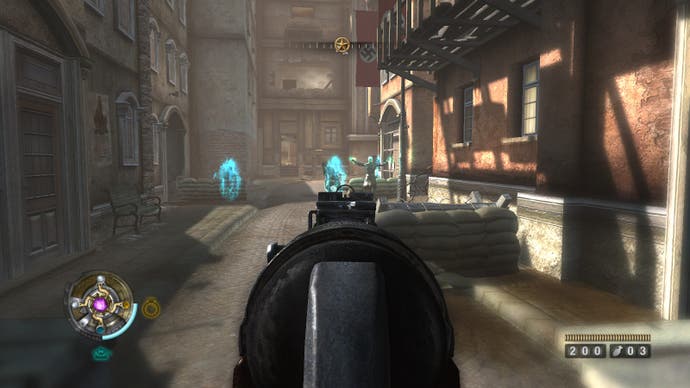Revisiting Raven's Wolfenstein
The forgotten order.
With Wolfenstein 2: The New Colossus due out next week, I'm sure I'm not the only one revisiting some of the highlights of the series. Wolfenstein 3D invented the FPS genre. Return To Castle Wolfenstein provided a refreshing alternative to the proto-Call of Duty world of Medal of Honor. Wolfenstein: The New Order rejuvenated the franchise.
But there's one game in the series that's often overlooked: 2009's Wolfenstein, by Raven Software.
The other games in the series are often seen as classics, whereas Raven's Wolfenstein is considered a massive misstep. At the time it felt like no one knew quite what to do with it. It's not available digitally anywhere. Even the game's bluntly straightforward title suggest it's not entirely sure how to set itself apart.
But is this Wolfenstein really that bad? If we're going by story alone, yes it is. Series protagonist BJ Blazkowicz gets a special medallion that gives him neat powers and goes to the town of Isenstadt to stop the Nazis doing all sorts of nasty mystical things. He stops them by shooting stuff real good, a castle (not Wolfenstein) blows up and then the credits roll. There are a few betrayals along the way, though it's hard to care when all the characters are so boring. Even BJ himself feels like a blank slate that showed more emotion in the technologically limited Wolfenstein 3D.

It's still considered canon. Series antagonist Wilhelm 'Deathshead' Strasse appears, as does another chaingun-wielding member of Wolfenstein 3D's Grosse family. Caroline Becker is a major character in The New Order and she's back in The New Colossus, but she was first introduced in Raven's Wolfenstein. Admittedly she has a lot more personality now. Back then her only role was to give missions, get captured and shot.
Still, the only actual colossal error in judgement Raven made was in giving Wolf 2009 an open-world city hub. Isenstadt is dull, cramped, and is irritating to navigate. Clearly Raven's ambitions for Wolfenstein were undone by a tight budget - perhaps if they'd ditched the cramped city hub for something more linear that they could control and polish, they might have had more luck elsewhere.
The main levels are claustrophobic. Contrast and compare, for example, the airfield level of 2001's Return To Castle Wolfenstein, where BJ could snipe soldiers from miles away and had full freedom to accomplish his objectives in a non-linear fashion. Wolfenstein 2009's airfield level, on the other hand, is a series of linear rooms with the only outdoor section carefully fenced-in by, well, a fence.
Once you get down to the first-person shooting though, it cannot be denied that it is actually fun. And you know what? In terms of combat, a.k.a. the most important part of any FPS, I'd say that's what really matters.
The weapons are deliciously over the top. One of the big problems with Return To Castle Wolfenstein was that its best weapon, the Flamethrower, was mostly useless. That's not a problem in the slightest in Wolfenstein 2009, as a quick spurt of flame can set entire rooms - and patrols of soldiers - ablaze. There's not much room for regular weapons here - save staples such as a machine gun and sniper rifle - with the rest of the arsenal a combination of the occult and experimental. An electric bolt from the Tesla Gun will see soldiers scream distressingly loud as they convulse and burn, while the Particle Cannon will vaporise them completely. It's grotesque, and brilliantly fun.

This overstated comic book violence all comes together in the Veil, Wolfenstein 2009's big innovation. It's another dimension that the player can flip to at will, granting them access to powers such as Bullet Time or Shield. While the Veil has the side effect of making regular enemies even easier, having a magical edge which sometimes can be used against the player does give Wolfenstein 2009 its own unique flavour.
So what was the problem? It's undoubtedly not a classic of the FPS, but the timing of its release certainly hampered its chances. Back in 2009, straightforward first-person shooters were becoming passé. This was an era that produced The Orange Box, Halo 3, FEAR., Modern Warfare, Far Cry 2, Crysis, BioShock, and a merely 'good' first-person shooter just wouldn't cut it. It wasn't until 2014, when an audience starved of such fare had built up quite an appetite, that the idea of a straightforward and unashamedly fun first-person shooter would be welcomed.
Wolfenstein 2009 undoubtedly has its problems, from an over-protective mission marker to the half-baked repetitive open world, but for me the biggest issue is how hard it is to track down a copy. Raven's Quake 4 is out on Steam and GOG, yet you won't find Wolfenstein on such platforms.
The world remains utterly determined to forget Wolfenstein 2009, and I don't think that's fair. It may well be inferior to Machine Games' Wolfenstein: The New Order and lacks the confidence Raven found with the brilliant Singularity. "Can we appreciate games ironically yet," asked Dan Whitehead back in Eurogamer's original review. Eight years on, when The New Colossus still feels like a dazzling outlier in a time of bloated and often po-faced first-person shooters, that time may well be now.








